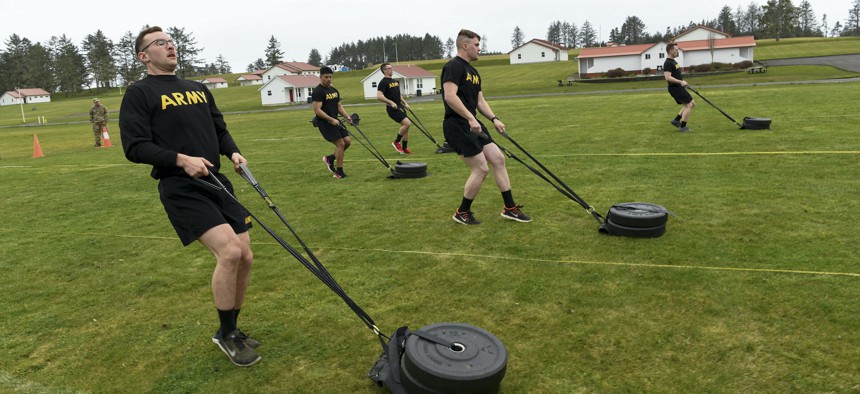
Oregon Army National Guard Spc. Wyatt Walls (left) takes part in the Army Combat Fitness Test (ACFT) during the 2022 Best Warrior Competition, March 17, at Camp Rilea near Warrenton, Ore. Air National Guard / John Hughel
Army Replaces Decades-Old Fitness Test, But Keeps Age- and Gender-Based Scoring
Several years of experiments showed a single-standard approach to be detrimental to the overall force.
When Army leaders set out to update the decades-old physical-fitness test, senior leaders sought, in part, to create a new test that would judge all soldiers against a single standard. But during several years of experimentation, they found that women and other groups were failing at rates that threatened to leave the force short of key personnel. On Wednesday, service leaders announced the final form of the new Army Combat Fitness Test—and that it would return to scoring personnel based on their gender and age.
“It's the Army's intent that the transition to full implementation of the ACFT will not adversely or disproportionately affect any soldier or group. This is really important to us,” said Brig. Gen. Scott Naumann, the Army’s director of training in the office of the deputy chief of staff, G-3/5/7.
Naumann and other senior Army officials spoke to reporters this week ahead of the service’s announcement on the final composition and implementation of the ACFT.
The six-event ACFT will replace the three-event Army Physical Fitness Test on April 1, and active-duty soldiers will begin to be officially scored on it on Oct. 1. The Army uses the biannual fitness test to assess soldiers’ physical fitness, but also their performance as a soldier and potential for promotions or education. Soldiers who fail a fitness test may retake it, but repeated failures risk career setbacks and even being kicked out of the Army.
In 2012, following years of combat in Iraq and Afghanistan, Army leaders decided to update their fitness test, seeking a better way to promote fitness and reduce injuries. The goal was to measure 10 components of physical fitness, including agility, balance, and flexibility, instead of just the one—muscular endurance—in the old test, said Brig. Gen John Kline, the commander of the Center for Initial Military Training.
They also decided to do away with the old test’s scoring based on a soldier’s age or gender, something none of the other services had done.
“Combat is age- and gender-neutral,” Maj. Gen. Lonnie Hibbard, a predecessor of Kline’s, told the Washington Post in 2020. “And so regardless of your gender or, more importantly, your [military profession], we have to ensure that everybody is prepared for combat.”
In 2019, the new test was rolled out for testing. The test went through three iterations with gender- and age-neutral scoring systems, like minimum standard scores and performance tiers. It was also focused on predicting how well soldiers would do in combat tasks like moving an injured soldier.
By 2020, lawmakers reviewing the collected data expressed concerns that too few women participated in the study that designed the test and too many were failing it once it was rolled out. In the 2021 National Defense Authorization Act, Congress directed the Army to have an independent assessment of the test and its impacts on the force.
The RAND study released Wednesday found that certain groups who took the ACFT 3.0 test failed at noticeably higher rates.
“Women, older soldiers, [National] Guard and Reserve personnel, and soldiers in some occupational specialties are experiencing these lower pass rates. The differences in pass rates were biggest between the genders: roughly half of enlisted women passed versus 85 to 90 percent of men, depending upon the component,” Chaitra Hardison, the lead author of the RAND study, told reporters.
Because the fitness test factors into the career progression of soldiers, this threatened to disproportionately reduce the number of soldiers in these groups.
Grinston said they listened to what the RAND study said and made changes because “we don’t want to disadvantage our soldiers.”
The Army also moved away from using the fitness test to predict performance in combat tasks to one that is a general assessment of physical fitness.
Having ACFT be a general fitness test with an age-and-gender-based scoring scale more accurately assesses an individual’s physical fitness, said Naumann.
“What is different is that this is a much better test. It's much more comprehensive, it looks at all different aspects of fitness, from endurance to strength to aerobic capacity,” he said.
Also, the Army will be providing more equipment and training plans to help soldiers prepare for the test. A “governance structure” will also be put in place to ensure oversight of the test’s implementation over time, collect data on the test, and provide recommendations to senior leaders.
With these changes in place, the Army can move forward with full implementation on April 1. Active-duty soldiers will have six months to train for the final revision of the test during another grace period before they officially record their scores starting Oct. 1. Army Reserve and National Guard soldiers have a year to train before their scores are recorded starting April 1, 2023.
The Army will still need to convince those criticizing the new test for having different grading for men and women, and one way Grinston believes that can be done is by presenting it as a better test of fitness.
“I think the overall scoring of the test is that it is a much harder test than what we had in the past. And when you look at that, there's always going to be that I have a different scoring of the test. We just have to communicate to our soldiers that this is a much better test than what we had in the past,” Grinston said.
One way of reducing the stigma that could come from the scaled scoring system is pointing to other areas where the Army has had success with gender neutral standards like Ranger School.
“So through other forums, we have eliminated some of the stigma… Because we've seen when we've gone to gender neutral for Ranger School, everyone has performed well and you can see that,” he said.
Grinston acknowledged that he was “almost certain” adjustments would be made over time to the test after implementation, for example to the scoring or recovery days between tests, as they continue to gather more data and feedback as soldiers take it, but probably not major changes such as to the events.
“We had the APFT for 40 years. That thing changed multiple times. And so, for the Army to hold on to something just for the sake of not changing is wrongheaded,” said Naumann.
“We want to make sure that we're evolving with the times to ensure that we have a culture of fitness and that we're building fit and ready soldiers to meet the demands of the modern battlefield. And this test will do that.”







